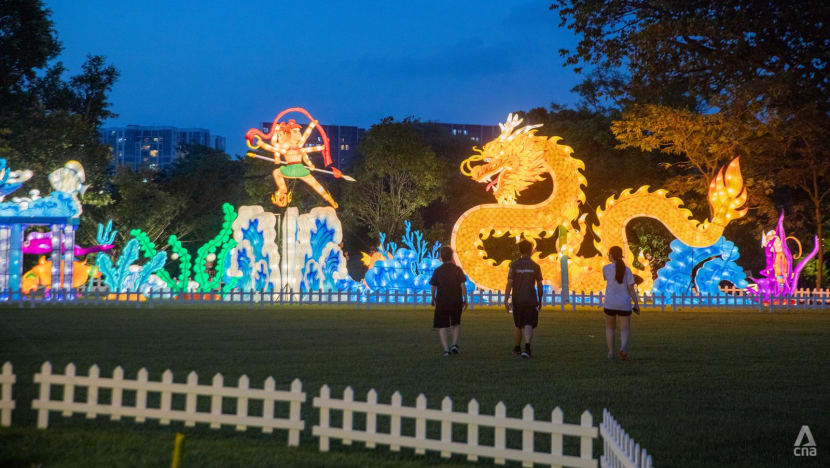An edible garden, waterfall and 'breathing gallery': Chinese and Japanese gardens reopen with new attractions
Existing landmarks such as the Chinese Garden's Grand Arch have also been improved with a new gallery and restaurant.

Visitors can now look out for an edible garden and a bamboo grove leading to a waterfall at the Chinese Garden, as well as an indoor "breathing gallery" for terrestrial and aquatic species at the Japanese Garden. (Photos: CNA/Ili Nadhirah Mansor)

This audio is generated by an AI tool.
SINGAPORE: Fancy a taste of 10 different types of edible plants?
Visitors can now do so at the Chinese Garden, which reopened on Sunday (Sep 8), together with the Japanese Garden.
The reopening marks the complete development of Jurong Lake Gardens - Singapore's first national gardens in the heartlands - the National Parks Board (NParks) said in a media release.
Jurong Lake Gardens, which spans 90ha, also includes the Lakeside Garden.
In 2014, then-Prime Minister Lee Hsien Loong announced during his National Day Rally speech that the Chinese and Japanese gardens would be combined with Jurong Lake Park - the current Lakeside Garden - to form Jurong Lake Gardens and serve as the centrepiece of modern Jurong.
Rejuvenation works then began in 2019 after extensive public consultation to "sensitively enhance" the Chinese and Japanese gardens, while preserving their natural ambience and distinctive cultural character, said NParks.
"Tropical horticulture was another key focus, with the landscaping and planting palette carefully curated to bring out the colours and textures of the tropics," it added.

On Thursday, members of the media were given a preview of the two gardens ahead of the reopening.
Speaking to reporters, NParks' group of director for Jurong Lake Gardens Kartini Omar said: "With the completion of the Jurong Lake Gardens, we hope that the gardens will provide a vision for a better tomorrow, one that provides ecologically, socially as well as climate-resilient parks and gardens for the future."
In its media release, NParks also said the completed Jurong Lake Gardens "brings to fruition" larger plans to ensure green spaces are within easy reach and further integrated into the urban landscape.
It added that this provides a healthy living environment in a City in Nature - which Singapore aims to transform into as part of its 2030 goals for sustainable development.
At the newly reopened Chinese and Japanese gardens, visitors can enjoy various amenities, including new floral and aquatic gardens, pavilions and galleries, as well as recreational and community spaces.
Several familiar landmarks at both gardens have also been improved, following feedback from the public to preserve them.
Joining the opening event on Sunday, Mr Lee, who is now senior minister after stepping down in May, unveiled a commemorative plaque and planted a Syzygium aqueum or water apple tree.
EDIBLE GARDEN, WATERFALL
Among several new attractions introduced at the Chinese Garden is the Edible Garden, designed to connect people with nature and share knowledge on growing one's own food.
It comprises several smaller gardens, each growing different types of edible plants such as flowers that can be eaten, climbers as well as herbs and spices. Some plants visitors can look out for include cranberry hibiscus, kang kong, balloon vine and sweet basil.
Gardeners also have a chance to turn their harvested plants into dishes at an outdoor kitchen.


Nestled within the Edible Garden is a plant factory, an indoor facility that cultivates edible plants by hydroponics or substrate-based methods. Plants such as basil, sage, rosemary and thyme, are grown here.
The Chinese Garden is now also home to a bamboo grove which leads to a waterfall. Wind generated by the waterfall creates a "cool corridor" for visitors walking through the tunnel which is enclosed by bamboo clusters.

Other newly added features include the Cascading Creek, a riverine habitat with a boardwalk showing the different flora and fauna found along the river of a typical Southeast Asian forest.
There is also a courtyard with a pavillion surrounded by shallow pools and 3m-high waterfalls known as the Water Wall Court, as well as the Harvest Moon Terrace, which features a number of cabanas with lanterns and mirrors the Silver Moon Terrace at the Japanese Garden across the lake.



New community spaces such as the Pagoda Plaza serves as a main gateway into Chinese Garden for visitors who are coming from Chinese Garden MRT station.
Meanwhile, the Ficus Lawn can accommodate more than 3,000 people and provides a large outdoor space for community events. Visitors can also use the lawn for recreational activities, picnics and gatherings.
Familiar landmarks at the Chinese Garden, such as the Grand Arch, Cloud Pagoda and Twin Pagoda, Bonsai Garden and Stoneboat have also been spruced up with new amenities, said NParks.
For one, a new building has been added to the Grand Arch, which houses the new Jurong Lake Gardens Gallery and a restaurant.
The gallery traces over six decades of the gardens' history and development from past to present day through archival photos, artefacts and interactive displays.
The Bonsai Garden also has its own gallery for visitors to learn more about the art form of bonsai.


TERRARIUMS AND AQUARIUMS
Highlights at the Japanese Garden include the new Water Lily Garden, home to the largest water lily collection in Singapore with over 150 varieties.
There is also the new Sunken Garden with a cenote-inspired feature as its centrepiece. A cenote is a deep natural well or sinkhole, formed by the collapse of surface limestone that exposes groundwater underneath.


Visitors can also look out for the Breathing Gallery, an indoor vivarium or an enclosed area where plants and animals are kept under conditions that simulate their natural ecosystem.
It showcases terrestrial and aquatic species in terrariums, aquariums and paludariums. A paludarium incorporates both terrestrial and aquatic elements.
The terrestrial zone in the Breathing Gallery features a 2.4m-long terrarium that has vampire crabs, fish and plants such as jewel orchids. At the aquatic zone, aquarium displays showcase different styles of aquascaping - the craft of arranging aquatic plants - and fish species.


There is also a living room zone designed for lounging and relaxing, and can be converted into a small workshop space for terrarium making.
Everyday furniture items, such as cabinets and shelves, are also filled with foliage and plants for visitors to draw inspiration from and create their own "green sanctuary" at home.
Like the Chinese Garden, the Japanese Garden also has various indoor and sheltered spaces suitable for both large-scale and intimate events. These include the Guesthouse, which can accommodate up to 1,000 people, as well as the adjacent Guest Pavilion and Teahouse.
The largest edition of Lights by the Lake - Jurong Lake Gardens' signature Mid-Autumn Festival event - will also be held in line with the reopening of the two gardens.
From Sep 8 to 22, more than 300 hand-crafted lanterns will be lit up nightly.
Additionally, Singapore Post will also be launching the Jurong Lake Gardens stamp series illustrating four new and existing attractions from Sep 9.



SUSTAINABLE MATERIALS AND COMMUNITY INVOLVEMENT
The refreshed Chinese and Japanese gardens also show continued focus on sustainability, said NParks.
For example, several buildings within the Jurong Lake Gardens, such as the Guesthouse, were built with mass-engineered timber, a building material comprising engineered wood products sourced from sustainably managed forests.
All footpaths within the Chinese and Japanese gardens are made of carbon dioxide mineralised concrete, which utilises a technology that recycles the gas, while lowering carbon emissions during the construction process.
At the same time, the community also played a key role in the revamp of Chinese and Japanese gardens, said NParks.
The statutory board said it gathered more than 14,000 suggestions from November 2016 to April 2017 for the gardens, and incorporated them into their design where feasible.
NParks also took into consideration suggestions from industry stakeholders and practitioners on carrying out the rejuvenation works sensitively.
"Altogether, the rejuvenated Chinese and Japanese gardens will complement Lakeside Garden's existing offerings, providing the public with even more recreational options within the first national gardens in the heartlands."
Speaking at the opening on Sunday, Mr Lee said that during a visit to the Chinese and Japanese gardens 10 years ago, he noticed they still looked "the same as they did in the 1970s".
"So I suggested to the planners to consider upgrading and refreshing the gardens. Keep the landmarks, but let's do something more with the gardens, to make them even better," he said.
The first phase of the rejuvenation comprised mainly the Lakeside Garden which was completed in 2019. It has since welcomed 25 million visitors, said Mr Lee.
"This second phase which includes the Chinese and Japanese gardens took a little longer because of COVID-19, but it has been well worth the wait," he added.
"Jurong Lake Gardens will cater to visitors young and old, fitness junkies and weekend warriors, human beings and pets - there is something for everybody."
Pointing to a stone at the Grand Arch commemorating the official opening of the Chinese Garden unveiled by then-Finance Minister Hon Sui Sen in 1975, Mr Lee said that "piece" of history records a time of rapid progress and development both for Jurong and the nation.
The late minister had then said visits to the Chinese Garden should provide welcome relief from the hectic pace of life, Mr Lee said.
"So in this same spirit, may the newly rejuvenated gardens offer Singaporeans a green sanctuary for many decades to come."















